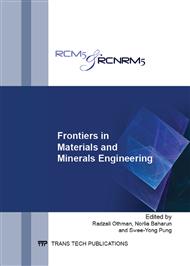[1]
S. Nai, J. Wei and M. Gupta, Interfacial intermetallic growth and shear strength of lead-free composite solder joints", Journal of Alloys and Compounds, 473 (2005), pp.100-106.
DOI: 10.1016/j.jallcom.2008.05.070
Google Scholar
[2]
M. Matin, W.P. Vellinga, M. Geers, Microstructure evolution in a Pb-free solder alloy during mechanical fatigue, Materials Science and Engineering A 431 (2006), pp.166-174.
DOI: 10.1016/j.msea.2006.05.144
Google Scholar
[3]
X.Y. Zhao, M.Q. Zhao, Q.X. Cui, M.X. Tong, Effect of cerium on microstructure and mechanical properties of Sn-Ag-Cu system lead-free solder alloys, Transactions of Nonferrous Metals Society of China 17 (2007), pp.805-810.
DOI: 10.1016/s1003-6326(07)60178-2
Google Scholar
[4]
L. Zhang, S. Xue, Y. Chen, Z. Han, J. Wang, S. Yu, F. Lu, Effects of cerium on Sn-Ag-Cu alloys based on finite element simulation and experiments, Journal of Rare Earths 27 (2009), pp.138-144.
DOI: 10.1016/s1002-0721(08)60208-2
Google Scholar
[5]
L. Gao,S. Xue, L. Zhang, Z. Sheng, F. Ji, W. Dai, S. Yu, G. Zeng, Effect of alloying elements on properties and microstructures of SnAgCu solders, Microelectronic Engineering 87 (2010), p.2025-(2034).
DOI: 10.1016/j.mee.2010.04.007
Google Scholar
[6]
M.N. Islam, Y.C. Chan, A. Sharif, M.O. Alam, Comparative study of the dissolution kinetics of electrolytic Ni and electroless Ni-P by the molten Sn3. 5Ag0. 5Cu sodler alloy, Microelectronics Reliability 43 (2003), p.2031- (2037).
DOI: 10.1016/s0026-2714(03)00190-2
Google Scholar
[7]
S. Kang, P.A. Lauro, D.Y. Shih, D.W. Henderson, K.J. Puttlitz, Microstructure and mechanical properties of lead-free solders and solder joints used in microelectronic applications, IBM Journal of Research and Development 49 (2005), pp.607-620.
DOI: 10.1147/rd.494.0607
Google Scholar
[8]
B.L. Chen, G.Y. Li, Influence of Sb on IMC growth in Sn-Ag-Cu-Sb Pb free solder joints in reflow process, Thin solid films 462–463 (2004), pp.395-401.
DOI: 10.1016/j.tsf.2004.05.063
Google Scholar
[9]
A.A. El-Daly, A.E. Hammada, A. Fawzy, D.A. Nasrallh, Microstructure, mechanical properties, and deformation behavior of Sn–1. 0Ag–0. 5Cu solder after Ni and Sb additions, Material and Design, 43 (2013), pp.40-49.
DOI: 10.1016/j.matdes.2012.06.058
Google Scholar
[10]
L. Zhang, S.B. Xue, L.L. Gao, W. Dai, F. Ji, Y. Chen, S.L. Yu, Microstructure characterization of SnAgCu solder bearing Ce for electronic packaging, Microelectronic Engineering 88 (2011), pp.2848-2851.
DOI: 10.1016/j.mee.2011.05.021
Google Scholar
[11]
H.H. Manko, Soldering and soldering, McGraw-Hill, New York, (2001).
Google Scholar


